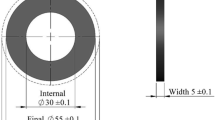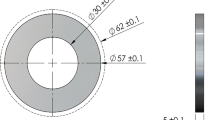Abstract
Characterized by the high heat generation, grinding has great difficulty in dry machining. As an alternative, it is proposed to apply abundant cutting fluid (conventional method) or a minimum amount of lubrication, which in turn dispenses with disposal costs and drastically reduces the volume of cutting fluid application during machining compared with the conventional technique. Despite this, the application of cutting fluids in MQL can cause clogging of the grinding wheel, damaging the workpiece quality. Against this, one of the techniques explored in the literature is the application of grinding wheel cleaning jet (WCJ), removing part of the layer adhered to the surface of the grinding wheel. Also, the present work proposes the cleaning of the cutting surface of the grinding wheel through the mechanical contact between Alumina (WCAB), and Teflon (WCTB) blocks with the cutting surface of the CBN grinding wheel, during cylindrical grinding of AISI 4340 steel hardened. Feed rates of 0.25; 0.50; 0.75, and 1 mm/min were applied under the following lubri-refrigeration conditions: conventional, MQL, and MQL with WCJ, WCAB, and WCTB. The parameters studied were roughness, roundness deviation, diametrical wheel wear, grinding power, acoustic emission, and microstructural analysis. The results showed that the WCAB and WCTB could improve grinding conditions compared with MQL without cleaning, mainly when applied with Alumina block. However, WCJ is the better condition associated with MQL. However, the conventional flood lubricant application remains with better results, indicant that it is necessary more effort to improve the MQL technique.









Similar content being viewed by others
References
Marinescu ID, Doi TK, Eckart U (2015) Handbook of ceramics grinding and polishing, 2nd edn. Elsevier
Sato BK, Rodriguez RL, Talon AG, Lopes JC, Mello HJ, Aguiar PR, Bianchi EC (2019) Grinding performance of AISI D6 steel using CBN wheel vitrified and resinoid bonded. Int J Adv Manuf Technol 105:2167–2182. https://doi.org/10.1007/s00170-019-04407-5
Talon AG, Lopes JC, Tavares AB, et al (2019) Effect of hardened steel grinding using aluminum oxide wheel under application of cutting fluid with corrosion inhibitors
de Mello HJ, de Mello DR, Rodriguez RL, Lopes JC, da Silva RB, de Angelo Sanchez LE, Hildebrandt RA, Aguiar PR, Bianchi EC (2018) Contribution to cylindrical grinding of interrupted surfaces of hardened steel with medium grit wheel. Int J Adv Manuf Technol 95:4049–4057. https://doi.org/10.1007/s00170-017-1552-y
Yao CF, Jin QC, Huang XC, Wu DX, Ren JX, Zhang DH (2013) Research on surface integrity of grinding inconel718. Int J Adv Manuf Technol 65:1019–1030. https://doi.org/10.1007/s00170-012-4236-7
Tunc LT, Gu Y, Burke MG (2016) Effects of minimal quantity lubrication (MQL) on surface integrity in robotic milling of austenitic stainless steel. Procedia CIRP 45:215–218. https://doi.org/10.1016/j.procir.2016.02.337
Kopac J, Krajnik P (2006) High-performance grinding-a review. J Mater Process Technol 175:278–284. https://doi.org/10.1016/j.jmatprotec.2005.04.010
Brinksmeier E, Mutlugünes Y, Klocke F, Aurich JC, Shore P, Ohmori H (2010) Ultra-precision grinding. CIRP Ann 59:652–671. https://doi.org/10.1016/J.CIRP.2010.05.001
Dudzinski D, Devillez A, Moufki A, Larrouquère D, Zerrouki V, Vigneau J (2004) A review of developments towards dry and high speed machining of Inconel 718 alloy. Int J Mach Tools Manuf 44:439–456. https://doi.org/10.1016/S0890-6955(03)00159-7
Alexandre FA, Lopes WN, Lofrano Dotto FR, Ferreira FI, Aguiar PR, Bianchi EC, Lopes JC (2018) Tool condition monitoring of aluminum oxide grinding wheel using AE and fuzzy model. Int J Adv Manuf Technol 96:67–79. https://doi.org/10.1007/s00170-018-1582-0
Bianchi EC, Rodriguez RL, Hildebrandt RA, Lopes JC, de Mello HJ, da Silva RB, de Aguiar PR (2018) Plunge cylindrical grinding with the minimum quantity lubrication coolant technique assisted with wheel cleaning system. Int J Adv Manuf Technol 95:2907–2916. https://doi.org/10.1007/s00170-017-1396-5
Trent EM, Wright PK (2000) Metal Cutting, 4th. Butterworth-Heinemann, Heat in metal cutting
Vyas A, Shaw MC (2008) Mechanics of saw-tooth chip formation in metal cutting. J Manuf Sci Eng 121:163–172. https://doi.org/10.1115/1.2831200
Rodriguez RL, Lopes JC, Hildebrandt RA, Perez RRV, Diniz AE, de Ângelo Sanchez LE, Rodrigues AR, de Mello HJ, de Aguiar PR, Bianchi EC (2019) Evaluation of grinding process using simultaneously MQL technique and cleaning jet on grinding wheel surface. J Mater Process Technol 271:357–367. https://doi.org/10.1016/j.jmatprotec.2019.03.019
Marinescu ID, Rowe WB, Dimitrov B, Ohmori H (2012) Tribology of abrasive machining processes
de Martini FL, Lopes JC, Volpato RS et al (2018) Comparative analysis of two CBN grinding wheels performance in nodular cast iron plunge grinding. Int J Adv Manuf Technol 98:237–249. https://doi.org/10.1007/s00170-018-2133-4
Chetan GS, Venkateswara Rao P (2015) Application of sustainable techniques in metal cutting for enhanced machinability: a review. J Clean Prod 100:17–34
Irani RA, Bauer RJ, Warkentin A (2005) A review of cutting fluid application in the grinding process. Int J Mach Tools Manuf 45:1696–1705. https://doi.org/10.1016/j.ijmachtools.2005.03.006
Debnath S, Reddy MM, Yi QS (2014) Environmental friendly cutting fluids and cooling techniques in machining: a review. J Clean Prod 83:33–47
Rodriguez RL, Lopes JC, Mancini SD, de Ângelo Sanchez LE, de Almeida Varasquim FMF, Volpato RS, de Mello HJ, de Aguiar PR, Bianchi EC (2019) Contribution for minimization the usage of cutting fluids in CFRP grinding. Int J Adv Manuf Technol 103:487–497. https://doi.org/10.1007/s00170-019-03529-0
Marinescu ID, Hitchiner M, Uhlmann E, Rowe WB (2007) Handbook of machining with grinding wheels, 1st edn. CRC Press, New York
de Martini FL, Lopes JC, Ribeiro FSF et al (2019) Thermal model for surface grinding application. Int J Adv Manuf Technol 104:2783–2793. https://doi.org/10.1007/s00170-019-04101-6
Marinescu ID (2013) Tribology of abrasive machining processes. William Andrew
Goindi GS, Sarkar P (2017) Dry machining: a step towards sustainable machining – challenges and future directions. J Clean Prod 165:1557–1571. https://doi.org/10.1016/j.jclepro.2017.07.235
Klocke F, Eisenblatter G (1997) Dry cutting. Keynote Pap 46:519–526. https://doi.org/10.1016/S0007-8506(07)60877-4
Sreejith P, Ngoi B (2000) Dry machining: machining of the future. J Mater Process Technol 101:287–291. https://doi.org/10.1016/S0924-0136(00)00445-3
Javaroni RL, Lopes JC, Sato BK, Sanchez LEA, Mello HJ, Aguiar PR, Bianchi EC (2019) Minimum quantity of lubrication (MQL) as an eco-friendly alternative to the cutting fluids in advanced ceramics grinding. Int J Adv Manuf Technol 103:2809–2819. https://doi.org/10.1007/s00170-019-03697-z
de Moraes DL, Garcia MV, Lopes JC, Ribeiro FSF, de Angelo Sanchez LE, Foschini CR, de Mello HJ, Aguiar PR, Bianchi EC (2019) Performance of SAE 52100 steel grinding using MQL technique with pure and diluted oil. Int J Adv Manuf Technol 105:4211–4223. https://doi.org/10.1007/s00170-019-04582-5
Hadad MJ, Tawakoli T, Sadeghi MH, Sadeghi B (2012) Temperature and energy partition in minimum quantity lubrication-MQL grinding process. Int J Mach Tools Manuf 54–55:10–17. https://doi.org/10.1016/J.IJMACHTOOLS.2011.11.010
Mao C, Zou H, Huang Y, Li Y, Zhou Z (2013) Analysis of heat transfer coefficient on workpiece surface during minimum quantity lubricant grinding. Int J Adv Manuf Technol 66:363–370. https://doi.org/10.1007/s00170-012-4330-x
Lopes JC, Garcia MV, Valentim M, Javaroni RL, Ribeiro FSF, de Angelo Sanchez LE, de Mello HJ, Aguiar PR, Bianchi EC (2019) Grinding performance using variants of the MQL technique: MQL with cooled air and MQL simultaneous to the wheel cleaning jet. Int J Adv Manuf Technol 105:4429–4442. https://doi.org/10.1007/s00170-019-04574-5
Lopes JC, Fragoso KM, Garcia MV, Ribeiro FSF, Francelin AP, de Angelo Sanchez LE, Rodrigues AR, de Mello HJ, Aguiar PR, Bianchi EC (2019) Behavior of hardened steel grinding using MQL under cold air and MQL CBN wheel cleaning. Int J Adv Manuf Technol 105:4373–4387. https://doi.org/10.1007/s00170-019-04571-8
D’Addona DM, Matarazzo D, De Aguiar PR et al (2016) Neural networks tool condition monitoring in single-point dressing operations. Procedia CIRP 41:431–436. https://doi.org/10.1016/j.procir.2016.01.001
Walker T (2013) The MQL handbook
Hadad M, Sadeghi B (2012) Thermal analysis of minimum quantity lubrication-MQL grinding process. Int J Mach Tools Manuf 63:1–15. https://doi.org/10.1016/j.ijmachtools.2012.07.003
Bianchi EC, Sato BK, Sales AR, Lopes JC, de Mello HJ, de Angelo Sanchez LE, Diniz AE, Aguiar PR (2018) Evaluating the effect of the compressed air wheel cleaning in grinding the AISI 4340 steel with CBN and MQL with water. Int J Adv Manuf Technol 95:2855–2864. https://doi.org/10.1007/s00170-017-1433-4
Tawakoli T, Hadad MJ, Sadeghi MH (2010) Influence of oil mist parameters on minimum quantity lubrication - MQL grinding process. Int J Mach Tools Manuf 50:521–531. https://doi.org/10.1016/j.ijmachtools.2010.03.005
Bianchi EC, Rodriguez RL, Hildebrandt RA, Lopes JC, de Mello HJ, de Aguiar PR, da Silva RB, Jackson MJ (2019) Application of the auxiliary wheel cleaning jet in the plunge cylindrical grinding with minimum quantity lubrication technique under various flow rates. Proc Inst Mech Eng Part B J Eng Manuf 233:1144–1156. https://doi.org/10.1177/0954405418774599
Lopes JC, Ventura CEH, Rodriguez RL, Talon AG, Volpato RS, Sato BK, de Mello HJ, de Aguiar PR, Bianchi EC (2018) Application of minimum quantity lubrication with addition of water in the grinding of alumina. Int J Adv Manuf Technol 97:1951–1959. https://doi.org/10.1007/s00170-018-2085-8
Kurt M, Köklü U (2012) Minimization of the shape error in the interrupted grinding process by using Taguchi method. Mechanika 18:677–682. https://doi.org/10.5755/j01.mech.18.6.3163
Maruda RW, Krolczyk GM, Wojciechowski S, Zak K, Habrat W, Nieslony P (2018) Effects of extreme pressure and anti-wear additives on surface topography and tool wear during MQCL turning of AISI 1045 steel. J Mech Sci Technol 32:1585–1591. https://doi.org/10.1007/s12206-018-0313-7
SHAW MC, COOKSON JO (2005) Metal cutting principles. Oxford university press, New York
King RI, Hahn RS, Devereux OF (2009) Handbook of modern grinding technology. J Eng Mater Technol 109:353. https://doi.org/10.1115/1.3225989
Lopes JC, Garcia MV, Volpato RS, de Mello HJ, Ribeiro FSF, de Angelo Sanchez LE, de Oliveira Rocha K, Neto LD, Aguiar PR, Bianchi EC (2019) Application of MQL technique using TiO2 nanoparticles compared to MQL simultaneous to the grinding wheel cleaning jet. Int J Adv Manuf Technol 106:2205–2218. https://doi.org/10.1007/s00170-019-04760-5
Hou ZB, Komanduri R (2004) On the mechanics of the grinding process, part III - thermal analysis of the abrasive cut-off operation. Int J Mach Tools Manuf 44:271–289. https://doi.org/10.1016/j.ijmachtools.2003.09.009
Reddy PP, Ghosh A (2014) Effect of cryogenic cooling on spindle power and G-ratio in grinding of hardened bearing steel. Procedia Mater Sci 5:2622–2628. https://doi.org/10.1016/j.mspro.2014.07.523
Reddy PP, Ghosh A (2016) Some critical issues in cryo-grinding by a vitrified bonded alumina wheel using liquid nitrogen jet. J Mater Process Technol 229:329–337. https://doi.org/10.1016/j.jmatprotec.2015.09.040
Bruzzone AAG, Costa HL, Lonardo PM, Lucca DA (2008) Advances in engineered surfaces for functional performance. CIRP Ann - Manuf Technol 57:750–769. https://doi.org/10.1016/j.cirp.2008.09.003
Hamilton DB, Walowit JA, Allen CM (1966) A theory of lubrication by microirregularities. J Basic Eng 88:177–185. https://doi.org/10.1115/1.3645799
Oliveira DDJ, Guermandi LG, Bianchi EC et al (2012) Improving minimum quantity lubrication in CBN grinding using compressed air wheel cleaning. J Mater Process Technol 212:2559–2568. https://doi.org/10.1016/j.jmatprotec.2012.05.019
Hadad MJ, Emami M, Sadeghi MH et al (2010) An investigation on surface grinding of AISI 4140 hardened steel using minimum quantity lubrication-MQL technique. Int J Mater Form 3:241–251
Umbrello D (2013) Analysis of the white layers formed during machining of hardened AISI 52100 steel under dry and cryogenic cooling conditions. Int J Adv Manuf Technol 64:633–642. https://doi.org/10.1007/s00170-012-4073-8
Lopes JC, de Martini FL, Domingues BB et al (2019) Effect of CBN grain friability in hardened steel plunge grinding. Int J Adv Manuf Technol 103:1567–1577. https://doi.org/10.1007/s00170-019-03654-w
Acknowledgments
The authors thank the São Paulo Research Foundation (FAPESP - processes 2013/00551-7, 2015/09197-7, and 2018/22661-2), Coordination for the Improvement of Higher Level Education Personnel (CAPES) and National Council for Scientific and Technological Development (CNPq) for their financial support of this research. The authors also thank companies Nikkon Ferramentas de Corte Ltda - Saint Gobain Group for providing the grinding wheel and ITW Chemicals for the donation of cutting fluids, and the authors thank all by support to the research and opportunity for scientific and technological development
Author information
Authors and Affiliations
Corresponding author
Ethics declarations
Conflict of interests
The authors declare that they have no conflict of interest.
Additional information
Publisher’s note
Springer Nature remains neutral with regard to jurisdictional claims in published maps and institutional affiliations.
Rights and permissions
About this article
Cite this article
Ribeiro, F.S.F., Lopes, J.C., Garcia, M.V. et al. Grinding performance by applying MQL technique: an approach of the wheel cleaning jet compared with wheel cleaning Teflon and Alumina block. Int J Adv Manuf Technol 107, 4415–4426 (2020). https://doi.org/10.1007/s00170-020-05334-6
Received:
Accepted:
Published:
Issue Date:
DOI: https://doi.org/10.1007/s00170-020-05334-6




